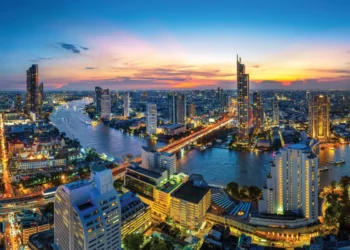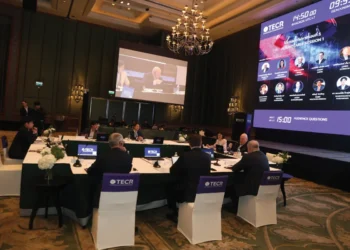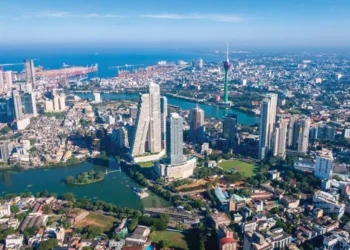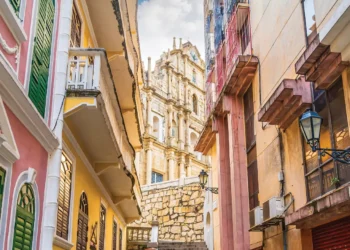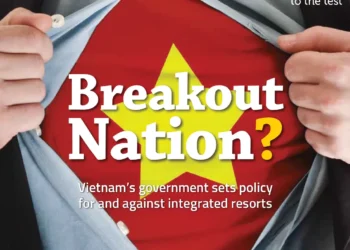The Philippines gaming market finds itself in a period of transition, with licensed casinos facing some headwinds while domestic online gaming enjoys an unprecedented surge. But there remains one constant – the Philippines is still the most intriguing market in Asia.

Two years after emerging from the COVID-19 pandemic and a year since staking its claim as the undisputed growth capital of Asian gaming on record revenues and a vast development pipeline, the Philippines finds itself at a crossroads.
In Manila’s Entertainment City precinct, widely considered the heart and soul of the nation’s land-based casino industry and home to City of Dreams Manila, Newport World Resorts, Okada Manila and Solaire Resort, revenues are falling – impacted by slower than expected international visitation and most tellingly the absence of Chinese VIPs.
 Ahead of the scheduled late 2025 launch of a fifth Entertainment City integrated resort – a US$1.1 billion hotel and casino project called LET X located within the broader Westside City precinct – the four existing operators have all reported declining year-on-year revenues in 2024. This included a substantial 13% decline during the first six months of the year, although Q3 saw a more modest 2% year-on-year fall, up 4% sequentially, according to official figures from regulator PAGCOR.
Ahead of the scheduled late 2025 launch of a fifth Entertainment City integrated resort – a US$1.1 billion hotel and casino project called LET X located within the broader Westside City precinct – the four existing operators have all reported declining year-on-year revenues in 2024. This included a substantial 13% decline during the first six months of the year, although Q3 saw a more modest 2% year-on-year fall, up 4% sequentially, according to official figures from regulator PAGCOR.
But it’s not all bad news.
In November, PAGCOR revealed that total industry-wide GGR (gross gaming revenue) had reached Php94.6 billion (US$1.61 billion) in the September quarter, representing a 37.5% increase over the same period in 2023 and 6% higher than in Q2.
While licensed casinos suffered a year-on-year decline, the sizeable improvement was driven by the emerging eGames sector, comprising eBingo, eGames, specialty games and sports betting, which chipped in Php35.7 billion (US$609 million) in GGR in Q3, up from just Php6.32 billion (US$108 million) a year earlier.

For traditional land-based operators like those in Entertainment City and regionally in places like Clark and Cebu, this presents both a challenge – the gradual erosion of table game play – and an opportunity, mainly via the growing PIGO segment through which they are now allowed to offer online gaming to domestic customers.
“The Philippines’ market on the surface appears very robust with growing revenues, however looking at where the growth is coming from, there are concerns for the traditional land-based casinos,” explains Scott Feeney, Executive Director of GCG Gaming Advisory Services.

“We may be getting close to a critical juncture where the resorts really have to look at their overall hotel, retail, event, and food and beverage offerings more closely than ever, and see these as becoming more critical to overall revenues rather than being so solely reliant on the traditional gaming floor. Revenue streams are being tested and new revenue streams evolving. In the Philippines, as with Macau, the junket business model is stagnating and being replaced with a broader onsite and online offering.
“The online offerings from PAGCOR have shown a clear trend to what the potential market will be. Customers who would have frequented the land-based casino are now very comfortable foregoing that experience, which in the case of Solaire [Entertainment City] and Newport World Resorts has been offered for a decade. Markets become jaded, and the travel time to get to and from a land-based casino will never get easier or quicker. The online offering is just more compelling.”
 Concerns around the current growth trajectory of Manila’s Entertainment City resorts were reflected in a recent note from Maybank Securities, which cut its net revenue forecasts for Solaire operator Bloomberry Resorts Corp by 12% for both 2024 and 2025, mainly due to weaker GGR at Solaire Resort Entertainment City.
Concerns around the current growth trajectory of Manila’s Entertainment City resorts were reflected in a recent note from Maybank Securities, which cut its net revenue forecasts for Solaire operator Bloomberry Resorts Corp by 12% for both 2024 and 2025, mainly due to weaker GGR at Solaire Resort Entertainment City.
On the broader slowdown in Entertainment City, Maybank analyst Raffy Mendoza said this was largely attributable to “fewer fly-in Chinese VIP players” – although he observed that the recent opening of Solaire Resort North in Quezon City bodes well for the company long-term.
The absence of these Chinese VIPs remains a key sticking point for Manila-based operators and reflects a broader issue for Philippine tourism. In 2019, total visitor arrivals from China reached 1.74 million, making it the country’s second largest visitor source market behind only Korea (1.99 million). Last year, China fell to fifth on the Philippines’ visitor list with 263,836 arrivals, or just 15% of pre-COVID levels. By comparison, Korea – which maintained top spot with 1.44 million arrivals – was back to 72% of pre-COVID. As of end-October 2024, China sits fourth on the list of source markets with 280,301 arrivals, while Korea continues to sit well clear of any other nation with 1.32 million arrivals.

“I don’t see Chinese visitation returning to pre-pandemic levels,” says Feeney. “The return of the Chinese has been very slow, and if we see any sizeable gain over the next few years, it will most likely dissipate once Thailand’s casinos open up with their far more enticing location and without doubt amazing IR projects.”
All of which makes PAGCOR’s decision to regulate domestic online gaming during the COVID-19 pandemic look even wiser in hindsight. Widely known as PIGO (Philippine Inland Gaming Operators) – as opposed to the controversial and soon to be defunct POGO (offshore) industry – domestic online gaming licenses provide for a form of remote gaming whereby the games on offer must be connected to real gaming tables or slot machines located within a physical casino premises.
As such, these “remote gaming” platforms are operated by and from the likes of Solaire, Okada Manila and Newport World Resorts in Manila, Hann Resorts and Casino Plus in Clark, and NUSTAR Resort & Casino in Cebu, among others.

This, explained Tecnet Asia’s Suat Sirin during a panel session moderated by IAG at MGS Entertainment Show in late 2023, has been one of the reasons for the growth in the eGames sector. Players, he explained, have trust in the platforms.
“With the big casino operators entering the online space due to the pandemic, players now play against a brand, not a casino or operator. They know that if they win a big jackpot, the brand will pay them,” Suat said.
Niall Murray, founder and Chairman of Murray International Group, described the emergence of PIGO as an “exciting development” for the Philippines gaming industry.
“It emerged as a result of PAGCOR’s willingness to explore new arenas and sources of revenue,” he said. “Operators who have adopted PIGO are experiencing tremendous success and significant increases in revenue. PIGO complements land-based offerings and provides interesting alternatives for the guest. Synergies must be built continuously between PIGO and land-based offerings moving forward, especially with regard to points and bonus schemes, [but it] offers tremendous opportunities due to the remarkable advantages provided by its mobility, accessibility and lower operating costs.”
 Commenting on the online sector’s massive growth in 2024, Murray added, “One key factor in the success and growth of eGames is the fact that global surveys have shown that Filipinos use their mobile phones constantly, service is relatively inexpensive and they spend the most time online. The Philippines also has a young population with a median age of 24.5. These factors combined help drive eGames growth.”
Commenting on the online sector’s massive growth in 2024, Murray added, “One key factor in the success and growth of eGames is the fact that global surveys have shown that Filipinos use their mobile phones constantly, service is relatively inexpensive and they spend the most time online. The Philippines also has a young population with a median age of 24.5. These factors combined help drive eGames growth.”
For PAGCOR itself, the sector’s rapid rise has also come at an opportune time, having seen another important revenue stream evaporate when President Ferdinand Marcos Jr announced in June a ban on the offshore POGO industry, giving POGOs until 31 December to wind down their operations completely.

Recognizing the remote gaming opportunity, PAGCOR and its Chairman and CEO Alejandro Tengco have been gradually winding back taxes, with the license fees it charges the country’s integrated resort operators on gross gaming revenues generated through their online gaming operations already reduced from 50% to 35% and from 2025 to come down further to just 25%. Other land-based operators will pay 30%, also down from 50% two years ago.
“By lowering our license fees to be in line with global industry standards, we hope to attract and keep more investment in place,” Chairman Tengco said during a keynote address at the IAG Academy Summit in Manila in September.

“It should also encourage illegal online gaming operators to abandon the grey market and hopefully embrace the mainstream. PAGCOR will likewise continue to implement rational regulatory policies, monitor our licensees’ compliance and strengthen our cooperation with other government and law enforcement agencies to crack down on persistent illegal online gaming operations.”
GCG’s Feeney notes “The previous hinderances of signing up at the casino seem to have been replaced with simply signing up online. It appears to be a trend as the younger generation of customers comes through.
“From an operator’s perspective the PIGO online tables and machines, and the remote gaming slot machines, are far more efficient.

“The eGames sector is very popular with the lower- and middle-income target market. The lower betting limits are far more attractive to the majority of the population. Although the projections for future overall gaming revenue appear to be approaching US$6 billion to US$7 billion this year, it may be a case of eGames and eBingo, as recorded by PAGCOR in the first half of 2024, approaching 40% of gaming revenues.”
Despite such incredible momentum in the eGames sector, growth opportunities in the traditional land-based sector remain. All eyes will be on the scheduled 4Q25 launch of Entertainment City’s fifth integrated resort, a US$1.1 billion hotel and casino project located within Megaworld’s Westside City precinct currently being developed by Hong Kong-listed LET Group, formerly known as Suncity Group, and its Philippines subsidiary Suntrust Resort Holdings. Known as LET X, this new IR will increase competition in the Manila market but also boost the appeal of the Entertainment City cluster in the increasingly competitive Asian gaming market, with its gaming offerings to be complemented by a range of facilities including multiple theaters, a “grand opera house” and four cinemas, among others.

About an hour north, Bloomberry is tapping into the northern Manila market with its second integrated resort, Solaire Resort North – a US$1 billion tower capturing the local domestic customer for whom spending an hour or two in Manila’s infamous traffic to reach Solaire Entertainment City is no longer appealing. The early signs have been promising, with Solaire Resort North generating US$63 million in GGR and US$11 million in Adjusted EBITDA in its first full quarter of operations in Q3. Maybank estimates that the property will contribute 22% of Bloomberry’s total GGR by the end of 2025.
Also full of promise are the emerging gaming hubs of Clark and, to a lesser extent, Cebu. Clark, about a two-hour drive to the north of Manila’s Ninoy Aquino International Airport, is home to six licensed casinos, including Hann Casino Resort, Royce Hotel & Casino, D’Heights, Casino Plus, Midori and Fontana.
 More licenses are anticipated in the next few years, with Melco Resorts Chairman and CEO Lawrence Ho and his partners in City of Dreams Manila, Belle Corp, among those known to have expressed interest in recent times.
More licenses are anticipated in the next few years, with Melco Resorts Chairman and CEO Lawrence Ho and his partners in City of Dreams Manila, Belle Corp, among those known to have expressed interest in recent times.
Clark’s market leader, Hann, which in 2022 completed a US$500 million expansion that included the Philippines’ first Swissôtel, is currently in the midst of a further expansion of its gaming and non-gaming facilities and has plans to lift the game further via Hann Reserve – described as an “integrated leisure and lifestyle development” on 450 hectares of land in nearby New Clark City. Coming at a cost of US$3 billion once fully realized over the next decade, Hann Reserve will include three golf courses and multiple hotels, plus a mixed-use commercial center, retail, residences, an international school and a casino, among other facilities.
Importantly, given the popularity of Clark with Korean guests, the development will specifically target the Korean market, meaning its exposure to the sluggish Chinese customer base is limited.

“Clark is going to be the big growth story over the next few years,” explains Feeney. “There are multiple operators looking at Clark, as well as the expansion plans for Hann. Once Clark sees one or more additional IRs, it is going to place a lot of pressure on Manila. It’s simply a better experience, with each property within a few minutes of each other.”
Cebu, currently home to NUSTAR, shows similar promise, although the island’s broader gaming appeal will rely on the stalled Emerald Bay project being reborn. Newport World Resorts operator Travellers International, part of Philippines conglomerate Alliance Global Group, has also announced a boutique casino resort project in Cebu, as well as another in Boracay.

“I see Clark as reaching US$1 billion in gaming revenues within three to four years, whilst Cebu will take a decade or so,” Feeney adds.
While competition between operators will continue to grow, these new developments represent a golden ticket for industry suppliers who continue to view the Philippines as the single most exciting growth market in Asia.
“General land-based GGR has declined but EGM (electronic gaming machine) gaming hasn’t” explains Lloyd Robson, General Manager – Asia for Aristocrat Gaming. “The EGM segment continues to grow, and with the growth of online there is an increasing category of slot players building in the Philippines.
 “If you look to the EGM mass market, there is a lot of growth opportunity to tap into and we look forward to bringing new innovations to market.”
“If you look to the EGM mass market, there is a lot of growth opportunity to tap into and we look forward to bringing new innovations to market.”
Like Feeney, Robson sees diversification of non-gaming offerings as key to the Philippines’ IRs continuing to grow but says opportunities persist for those who can successfully leverage these attractions alongside their gaming floors.
“Improved infrastructure, different accommodation offerings and entertainment activities outside of gaming such as music concerts or sporting events to diversity revenue opportunities – we’re already seeing operators explore these factors, which is exciting,” he says.
“Innovation is also key. More and more we’re seeing operators willing to partner with manufacturers to create unique and memorable player experiences. For example, our recent activation with Studio City in Macau, with their Dragon Room, is a textbook example of how we are bringing innovative experiences to players in tandem with our customers. These marketing activations create a point of difference between gaming venues and are the vehicle to create game play experiences that extend beyond the gaming floor.
“With new IRs such as NUSTAR Resort and others set to open soon, the future of [the Philippines] seems very positive in terms of opportunities for growth.”
 Licensed casinos aside, Aristocrat was one of a handful of suppliers, alongside Light & Wonder, Konami and Korea’s KL Saberi, to have benefited from PAGCOR’s privatization efforts, with the regulator looking to sell off its 43 self-operated Casino Filipino branches by the time Chairman Tengco’s six-year term expires in 2028.
Licensed casinos aside, Aristocrat was one of a handful of suppliers, alongside Light & Wonder, Konami and Korea’s KL Saberi, to have benefited from PAGCOR’s privatization efforts, with the regulator looking to sell off its 43 self-operated Casino Filipino branches by the time Chairman Tengco’s six-year term expires in 2028.
Key to those efforts is significantly improving the look and feel of the Casino Filipino brand, including the replacement of 3,341 ageing slot machines with the same titles found in Entertainment City and beyond. An initial order of 1,968 machines was delivered in mid-September, PAGCOR recently revealed.
The jury is still out on how successful privatization will be – not all Casino Filipino branches were created equal – although Niall Murray insists the potential is there for those willing to invest.
“I think privatization is an excellent move,” says Murray, whose background comprises considerable experience in property openings and reopenings.
“It will be a disruptor to the industry. Now private investors can put new and exciting spins on traditional casino operations.
“They will obviously need to upgrade offerings and add non-gaming attractions to draw in customers. Many will succeed, but some will fail, so right-sizing the properties and getting the product and service mix right will be critical to success.
“Operations will need to be highly efficient, tightly controlled, regulated and optimized in order to succeed in an increasingly competitive market. These properties must be completely re-invented to succeed.”
 This is, Murray adds, a period of transition for the Philippines yet one that continues to show incredible potential – even if short-term headwinds persist for some.
This is, Murray adds, a period of transition for the Philippines yet one that continues to show incredible potential – even if short-term headwinds persist for some.
“I believe that Manila in particular and the Philippines in general has a lot of room to grow,” he says. “The key is to continuously improve, expand its offerings and appeal to a wider audience of local and regional visitors.
“Leading IR operators are investing in remodelling or expansions and are planning new developments. New properties such as Solaire Resort North, the enhancements at Hann and Newport World Resorts, and the opening of future properties on the horizon will breathe new life into the industry. Concerns can be minimized if operators renovate, add exciting gaming and non-gaming amenities to take on increasing regional competition and target alternative source markets for VIP and mass players.”
Feeney also sees upside for the industry, and specifically Manila.
“The market is not saturated in terms of there being four IRs,” he offers. “There is not a lack of people coming through the doors, rather the quality of the players and their gaming spend. Manila has the population to absorb the four current IRs and the new Westside.
“The new business objective will be to renovate the properties in the case of existing IRs or, in the case of Westside, build new configurations to meet the market situation moving forward. I’m sure we will see escalating head counts for Entertainment City overall. I expect to see reduced spend per head on traditional gaming but an increase in resort spending if the offering is correct and an increase in spend on the casino’s online products.”
The winds of change blow strong.








